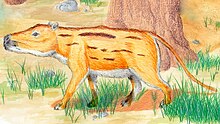| Didolodus | |
|---|---|

| |
| Scientific classification | |
| Domain: | Eukaryota |
| Kingdom: | Animalia |
| Phylum: | Chordata |
| Class: | Mammalia |
| Family: | †Didolodontidae |
| Genus: | †Didolodus Ameghino 1897 |
| Species | |
| |
| Synonyms | |
| |
Didolodus is an extinct genus of mammals from Middle Eocene Argentina. It is an ungulate mammal of uncertain affinities, possibly related to Litopterna, though this is uncertain due to the lack of reliable post-cranial remains, and for now remains Meridiungulata incertae sedis.[1] Its remains were found in the Sarmiento Formation of Patagonia.[2]
Didolodus probably was a quick-footed creature which probably lived like early ungulates such as Propalaeotherium, based on its highly similar teeth. It was around 60 centimetres (2.0 ft) in length, with short limbs and a long tail.[3]
Phylogeny
[edit]Cladogram after Gelfo and Sigé, 2011:[4]
| ||||||||||||||||||||||||||||||||||||||||||||||||||||
References
[edit]- ^ Javier Nicolás, The alleged astragalar remains of Didolodus Ameghino, 1897 (Mammalia, Panameriungulata) and a critic of isolated bone association models, 2012
- ^ Didolodus at Fossilworks.org
- ^ Palmer, D., ed. (1999). The Marshall Illustrated Encyclopedia of Dinosaurs and Prehistoric Animals. London: Marshall Editions. p. 246. ISBN 1-84028-152-9.
- ^ Javier N. Gelfo and Bernard Sigé (2011). "A new didolodontid mammal from the late Paleocene–earliest Eocene of Laguna Umayo, Peru" (PDF). Acta Palaeontologica Polonica. 56 (4): 665–678. doi:10.4202/app.2010.0067.









Well, that’s interesting to know that Psilotum nudum are known as whisk ferns. Psilotum nudum is the commoner species of the two. While the P. flaccidum is a rare species and is found in the tropical islands. Both the species are usually epiphytic in habit and grow upon tree ferns. These species may also be terrestrial and grow in humus or in the crevices of the rocks.
View the detailed Guide of Psilotum nudum: Detailed Study Of Psilotum Nudum (Whisk Fern), Classification, Anatomy, Reproduction